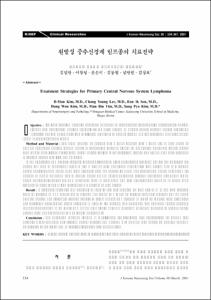KUMEL Repository
1. Journal Papers (연구논문)
1. School of Medicine (의과대학)
Dept. of Neurosurgery (신경외과학)
원발성 중추신경계 림프종의 치료전략
- Keimyung Author(s)
- Kim, El; Lee, Chang Young; Son, Eun Ik; Kim, Dong Won; Yim, Man Bin; Kim, Sang Pyo
- Journal Title
- 대한신경외과학회지
- Issued Date
- 2001
- Volume
- 30
- Issue
- 3
- Abstract
- Objective:We have currently changed treatment strategies to methotrexate(MTX)-based preirradiation chemotherapy with subsequent planned radiation for the initial therapy of primary central nervous system lymphoma(PCNSL). The aim of this study was to evaluate the results of treating PCNSL with chemotherapy plus radiotherapy(CRT) or radiotherapy(RT) alone.
Method and Material:This study involved 10 females and 3 males patients with a mean age of 54.2 years. All patients underwent surgery, open(8 cases) or stereotactic biopsy(5 cases) for histological diagnosis. Eleven tumors were diffuse large B-cell lymphomas. Tumor volume change in the follow-up images and survival time were evaluated in patients treated with CRT and RT alone. In the beginning, two patients received ProMACE-Cytabom chemotherapeutic regimen, but did not complete the course and died of progressive tumor 8 and 9 months after diagnosis, respectively. One patient died at 6 months before chemotherapy. These three were excluded from the survival analysis. Five patients(RT group) completed full courses of cranial irradiation with or without boost. For the current combined modality treatment, high-dose MTXbased chemotherapy(systemic and intrathecal MTX, IV vincristine, and oral procarbazine) followed by whole brain irrdiation to 45Gy to tumor was introduced in 5 patients of CRT group.
Result:A complete response was achieved in three of five who received RT only and in all of five who received CRT. All patients in CRT groups are in disease free status at a mean 23 months following therapy. The RT group patients refused any additional salvage therapy at tumor relapse and survived at mean 20 months from diagnosis. The Karnofsky performance status improved in eight of ten patients with treatment. The treatment toxicity included leukoencephalopathy in RT group and severe leukopenia, transient hepatitis, avascular necrosis of femoral head, hearing loss, and amenorrhea in CRT group, respectively.
Conclusion:The combined modality therapy of MTX-based chemotherapy plus radiotherapy for PCNSL may enhance tumor response and improve patient survival. The patients who received CRT should be carefully followed up because of the higher risk of treatment-induced late neurotoxicity.
- Alternative Title
- Treatment Strategies for Primary Central Nervous System Lymphoma
- Publisher
- School of Medicine
- Citation
- 김일만 et al. (2001). 원발성 중추신경계 림프종의 치료전략. 대한신경외과학회지, 30(3), 334–341.
- Type
- Article
- ISSN
- 1225-8245
- Appears in Collections:
- 1. School of Medicine (의과대학) > Dept. of Neurosurgery (신경외과학)
1. School of Medicine (의과대학) > Dept. of Pathology (병리학)
- 파일 목록
-
-
Download
 oak-bbb-1975.pdf
기타 데이터 / 7.1 MB / Adobe PDF
oak-bbb-1975.pdf
기타 데이터 / 7.1 MB / Adobe PDF
-
Items in Repository are protected by copyright, with all rights reserved, unless otherwise indicated.